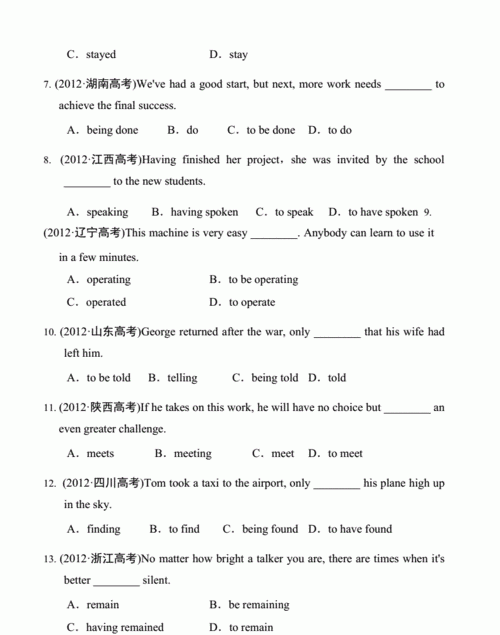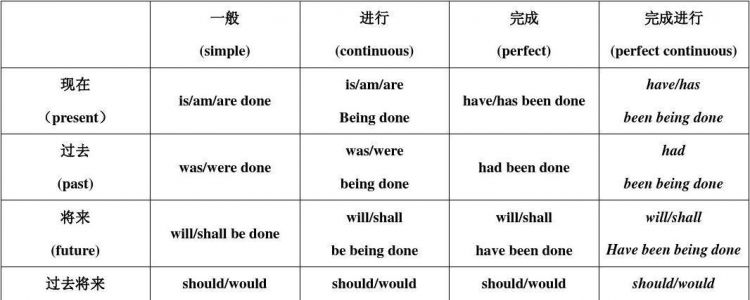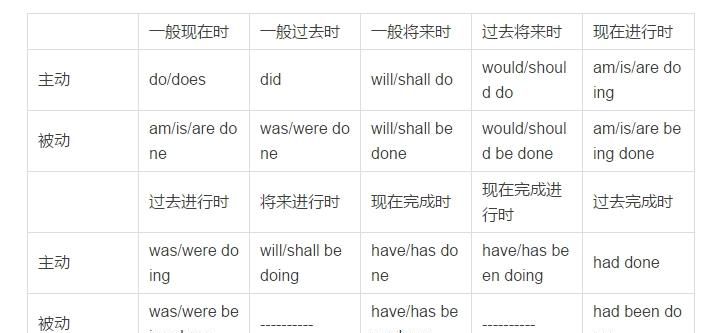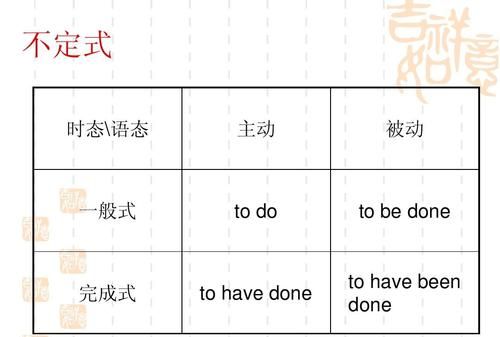本文目录
八年级下册英语动词不定式讲解
英语动词不定式的用法总结 动名词与不定式 1) 动名词与不定式的区别: 动名词表达的是: 状态,性质,心境,抽象,经常性,已发生的 不定式表达的是: 目的,结果,原因,具体,一次性,将发生的 2) 接不定式或动名词,意义相同。 3) 动名词与不定式语义不同的有11 组: 1 stop to do stop doing 2 forget to do forget doing 3 remember to do remember doing 4 regret to do regret doing 5 cease to do cease doing 6 try to do try doing 7 go on to do go on doing 8 afraid to do afraid doing 9 interested to do interested doing 10 mean to do mean doing 11 begin/ start to do begin/ start doing 不定式的时态和语态 时态\语态 主动 被动 一般式 to do to be done 进行式 to be doing 完成式 to have done to have been done 完成进行式 to have been doing 1) 现在时:一般现在时表示的动词,有时与谓语动词表示的动作同时发生,有时发生在谓语动词的动作之后。 He seems to know this. I hope to see you again. = I hope that I’ll see you again. 我希望再见到你。 2) 完成时:表示的动作发生在谓语动词表示的动作之前。 I’m sorry to have given you so much trouble. He seems to have caught a cold. 3) 进行时: 表示动作正在进行,与谓语动词表示的动作同时发生。 He seems to be eating something. 4) 完成进行时: She is known to have been wreaking on the problem for many years. 不定式的特殊句型Why not "Why not +动词原形"表达向某人提出建议,翻译为:"为什么不……?" "干吗不……?" 例如: Why not take a holiday? 干吗不去度假? 不定式的特殊句型so as to 1) 表示目的;它的否定式是so as not to do。 Tom kept quiet about the accident so as not to lose his job. 汤姆对事故保持沉默是为了不丢掉他的工作。 Go in quietly so as not to wake the baby. 轻点进去,别惊醒了婴儿。 2) so kind as to ---劳驾 Would you be so kind as to tell me the time? 劳驾,现在几点了。 不定式的特殊句型too…to… 1)too…to 太…以至于… He is too excited to speak. 他太激动了,说不出话来。 ---- Can I help you ? 需要我帮忙吗? ---- Well, I’m afraid the box is too heavy for you to carry it, but thank you all the same. 不用了。这箱子太重,恐怕你搬不动。谢谢您。 2) 如在too前有否定词,则整个句子用否定词表达肯定, too 后那个词表达一种委婉含义,意 为"不太"。 It’s never too late to mend. (谚语) 改过不嫌晚。 3) 当too 前面有only, all, but时,意思是:非常… 等于very。 I’m only too pleased to be able to help you. 我非常高兴能帮助你。 He was but too eager to get home. 他非常想回家。 动词不定式的否定式 Tell him not to shut the window… She pretended not to see me when I passed by. 我走过的时候,她假装没看见。 典型例题 1)Tell him ___ the window. A. to shut not B. not to shut C. to not shut D. not shut 答案:B。 tell sb to do sth 的否定形式为tell sb not to do sth. 2) She pretended ___ me when I passed by. A. not to see B. not seeing C. to not see D. having not seen 答案:A。 pretend 后应接不定式。其否定形式为pretend not to do sth.。 3)Mrs. Smith warned her daughter ___ after drinking. A. never to drive B. to never driver C. never driving D. never drive 答案:A。warn sb to do sth. 的否定形式为warn sb not to do sth. 此处用的是否定词never. 4) The boy wanted to ride his bicycle in the street,but his mother told him ____. A. not to B. not to do C. not do it D. do not to 答案:A。not to 为not to do it 的省略形式。可以只用to这个词,而不必重复整个不定式词组。及物动词do后应有名词、代词等,否则不对,因此B,D不对。 5) The patient was warned ___ oily food after the operation. A. to eat no B. eating not C. not to eat D. not eating 答案:C。warn一词要求后用不定式,此处为不定式的被动,否定形式为be warned not to do。 动词不定式的句子成分 不定式作表语 不定式可放在be动词后面,形成表语。例如: My work is to clean the room every day. His dream is to be a doctor. 不定式作定语 不定式做定语通常要放在被修饰的词后。例如: I have a lot of work to do. So he made some candles to give light. 不定式作状语 1)目的状语 To… only to (仅仅为了), in order to, so as to, so(such)… as to… (如此……以便……) He ran so fast as to catch the first bus. 他飞快地跑以便赶上第一班车。 I come here only to say good-bye to you. 我来仅仅是向你告别。 2)作结果状语,表事先没有预料到的,要放在句子后面。 What have I said to make you angry. He searched the room only to find nothing. 3) 表原因 I’m glad to see you. 典型例题 The chair looks rather hard, but in fact it is very comfortable to ___. A. sit B. sit on C. be seat D. be sat on 答案:B. 如果不定式为不及物动词,其后应有必要的介词。当动词与介词连用时,常位于"形容词+动词不定式"结构的末尾。 不定式主语 1) It’s easy (for me) to do that.我做这事太容易了 easy, difficult, hard, important, possible, impossible, comfortable, necessary, better; the first, the next, the last, the best, too much, too little, not enough It’s so nice to hear your voice. 听到你的声音真高兴。 It’s necessary for you to lock the car when you do not use it. 当你不用车的时候,锁车是有必要的。 2) It’s very kind of you to help us. 他帮助我们,他真好。 Kind, nice, stupid, rude, clever, foolish, thoughtful, thoughtless, brave, considerate(考虑周到的), silly, selfish(自私的) 例句: It was silly of us to believe him. 我们真愚蠢,竟然相信了他。 It seemed selfish of him not to give them anything. 他不给他们任何东西,这显得太自私了。 注意:1) 其他系动词如,look,appear等也可用于此句型 2) 不定式作为句子成分时,动词用单数形式。 3) 当不定式作主语的句子中又有一个不定式作表语时,不能用It is… to…的句型 (对)To see is to believe. 百闻不如一见。 (错)It is to believe to see. 不定式作补语 1) 动词+宾语+不定式(to do) advise allow appoint believe cause challenge command compel consider declare drive enable encourage find forbid force guess hire imagine impel induce inform instruct invite judge know like order permit persuade remind report request require select send state suppose tell think train trust understand urge warn 例句: a. Father will not allow us to play on the street. 父亲不让我们在街上玩耍。 b. We believe him to be guilty. 我们相信他是有罪的。 Find 的特殊用法: Find 后可用分词做宾补,或先加形式宾语,再加形容词,最后加带to 的动词不定式。find后也可带一个从句。此类动词还有get,have。 I found him lying on the ground. I found it important to learn. I found that to learn English is important. 典型例题: The next morning she found the man ___ in bed,dead. A. lying B. lie C. lay D. laying 答案:A.find的宾语后面,用分词或分词短语,起宾语补足语作用。现在分词表达主动,也表达正在进行,过去分词表达被动。 2) to + be 的不定式结构,作补语的动词。 Acknowledge, believe, consider, think, declare(声称), discover, fancy(设想), feel find, guess, judge, imagine, know, prove, see(理解), show, suppose, take(以为), understand We consider Tom to be one of the best students in our class. 我们认为汤姆是班上最好的学生之一。 典型例题 Charles Babbage is generally considered ___ the first computer. A. to invent B. inventing C. to have invented D. having invented 答案:A. 由consider to do sth. 排除B、D。. 此句只说明发明这一个事实,不定式后用原形即可。而C为现在完成时,发明为点动词一般不用完成时,且此处也不强调对现在的影响,因此不选C。 3) to be +形容词 Seem, appear, be said, be supposed, be believed, be thought, be known, be reported, hope, wish, desire, want, plan, expect, mean… The book is believed to be uninteresting. 人们认为这本书没什么意思。 4) there be+不定式 believe, expect, intend, like, love, mean, prefer, want, wish, undrstand We didn’t expect there to be so many people there.我们没料到会有那么多人在哪里。 注意 : 有些动词需用as 短语做补语,如regard, think believe, take, consider. We regard Tom as our best teacher. 我们认为汤姆是我们最好的老师。 Mary took him as her father . 玛丽把他当作自己的父亲。 不定式作宾语 1) 动词+ 不定式 afford aim appear agree arrange ask be decide bother care choose come dare demand desire determine expect elect endeavor hope fail happen help hesitate learn long mean manage offer ought plan prepare pretend promise refuse seem tend wait wish undertake 举例: The driver failed to see the other car in time. 司机没能及时看见另一辆车。 I happen to know the answer to your question. 我碰巧知道你那道问题的答案。 2)动词+不定式 ; 动词+宾语+不定式 ask, beg, choose, expect , hate, help intend like, love, need prefer, prepare, promise, want, wish… I like to keep everything tidy. 我喜欢每件东西都保持整洁。 I like you to keep everything tidy. 我喜欢你年使每件东西都保持整洁。 I want to speak to Tom. 我想和汤姆谈话。 I want you to speak to Tom. 我想让你和汤姆谈话。 3) 动词+疑问词+ to decide, know, consider forget, learn, remember, show, understand, see, wonder, hear, find out, explain, tell Please show us how to do that. 请演示给我们如何去做。 There are so many kinds of tape-recorders on sale that I can’t make up my mind which to buy.有这么多的录音机,我都拿不定主意买哪一种。 注意:疑问词带不定式在句中作成分时,谓语动词用单数。 The question is how to put it into practice. 问题是怎样把它付诸实施。

虚拟语气语法总结
小题1:(should)be protected/preserved 小题2:o be laughed at 小题3: being attacked 小题4:to have found 小题5:were, would go to |
试题分析: 小题1:(should)be protected/preserved 动词suggest(建议)后面的宾语从句使用“should+动词原形”构成的虚拟语气,should可以省略。 小题2:to be laughed at 固定搭配like to do sth;本句是不定式的被动语态to be done。 小题3: being attacked 介词of的后面要接动名词的形式doing;根据句意说明使用被动语态being done. 小题4:to have found 本句中不定式表示的是原因,不定式的完成式to have done表示不定式的动作发生在谓语动词之前。 小题5:were,would go to 本句是条件句中与现在相反的虚拟语气,从句使用过去时,或者were,主句使用“情态动词+动词原形” 点评:特别应注意名词单复数的变化,动词时态语态的变化,形容词和副词的变化,以及虚拟语气等具体语法的使用 |

关于动词不定式的问题
这个句子中是做宾语的.
动词不定式
7.1 不定式作宾语
1) 动词+ 不定式
afford aim appear agree arrange ask be decide bother care choose come dare demand desire determine expect elect endeavor hope fail happen help hesitate learn long mean manage offer ought plan prepare pretend promise refuse seem tend wait wish undertake
举例:
The driver failed to see the other car in time.
司机没能及时看见另一辆车。
I happen to know the answer to your question.
我碰巧知道你那道问题的答案。
2)动词+不定式 ; 动词+宾语+不定式
ask, beg, choose, expect , hate, help intend like, love, need prefer, prepare, promise, want, wish…
I like to keep everything tidy. 我喜欢每件东西都保持整洁。
I like you to keep everything tidy. 我喜欢你年使每件东西都保持整洁。
I want to speak to Tom. 我想和汤姆谈话。
I want you to speak to Tom. 我想让你和汤姆谈话。
3) 动词+疑问词+ to
decide, know, consider forget, learn, remember, show, understand, see, wonder, hear, find out, explain, tell
Please show us how to do that. 请演示给我们如何去做。
There are so many kinds of tape-recorders on sale that I can’t make up my mind which to buy.有这么多的录音机,我都拿不定主意买哪一种。
注意:疑问词带不定式在句中作成分时,谓语动词用单数。
The question is how to put it into practice.
问题是怎样把它付诸实施。
7.1 不定式作宾语
1) 动词+ 不定式
afford aim appear agree arrange ask be decide bother care choose come dare demand desire determine expect elect endeavor hope fail happen help hesitate learn long mean manage offer ought plan prepare pretend promise refuse seem tend wait wish undertake
举例:
The driver failed to see the other car in time.
司机没能及时看见另一辆车。
I happen to know the answer to your question.
我碰巧知道你那道问题的答案。
2)动词+不定式 ; 动词+宾语+不定式
ask, beg, choose, expect , hate, help intend like, love, need prefer, prepare, promise, want, wish…
I like to keep everything tidy. 我喜欢每件东西都保持整洁。
I like you to keep everything tidy. 我喜欢你年使每件东西都保持整洁。
I want to speak to Tom. 我想和汤姆谈话。
I want you to speak to Tom. 我想让你和汤姆谈话。
3) 动词+疑问词+ to
decide, know, consider forget, learn, remember, show, understand, see, wonder, hear, find out, explain, tell
Please show us how to do that. 请演示给我们如何去做。
There are so many kinds of tape-recorders on sale that I can’t make up my mind which to buy.有这么多的录音机,我都拿不定主意买哪一种。
注意:疑问词带不定式在句中作成分时,谓语动词用单数。
The question is how to put it into practice.
问题是怎样把它付诸实施。
7.2 不定式作补语
1) 动词+宾语+不定式(to do)
advise allow appoint believe cause challenge command compel consider declare drive enable encourage find forbid force guess hire imagine impel induce inform instruct invite judge know like order permit persuade remind report request require select send state suppose tell think train trust understand urge warn
例句:
a. Father will not allow us to play on the street.
父亲不让我们在街上玩耍。
b. We believe him to be guilty.
我们相信他是有罪的。
Find 的特殊用法:
Find 后可用分词做宾补,或先加形式宾语,再加形容词,最后加带to 的动词不定式。find后也可带一个从句。此类动词还有get,have。
I found him lying on the ground.
I found it important to learn.
I found that to learn English is important.
典型例题:
The next morning she found the man ___ in bed,dead.
A. lying B. lie C. lay D. laying
答案:A.find的宾语后面,用分词或分词短语,起宾语补足语作用。现在分词表达主动,也表达正在进行,过去分词表达被动。
2) to + be 的不定式结构,作补语的动词。
Acknowledge, believe, consider, think, declare(声称), discover, fancy(设想), feel find, guess, judge, imagine, know, prove, see(理解), show, suppose, take(以为), understand
We consider Tom to be one of the best students in our class.
我们认为汤姆是班上最好的学生之一。
典型例题
Charles Babbage is generally considered ___ the first computer.
A. to invent B. inventing C. to have invented D. having invented
答案:A. 由consider to do sth. 排除B、D。. 此句只说明发明这一个事实,不定式后用原形即可。而C为现在完成时,发明为点动词一般不用完成时,且此处也不强调对现在的影响,因此不选C。
3) to be +形容词
Seem, appear, be said, be supposed, be believed, be thought, be known, be reported, hope, wish, desire, want, plan, expect, mean…
The book is believed to be uninteresting.
人们认为这本书没什么意思。
4) there be+不定式
believe, expect, intend, like, love, mean, prefer, want, wish, undrstand
We didn’t expect there to be so many people there.我们没料到会有那么多人在哪里。
注意 : 有些动词需用as 短语做补语,如regard, think believe, take, consider.
We regard Tom as our best teacher. 我们认为汤姆是我们最好的老师。
Mary took him as her father . 玛丽把他当作自己的父亲。
7.3 不定式主语
1) It’s easy (for me) to do that.我做这事太容易了
easy, difficult, hard, important, possible, impossible, comfortable, necessary, better;
the first, the next, the last, the best, too much, too little, not enough
It’s so nice to hear your voice.
听到你的声音真高兴。
It’s necessary for you to lock the car when you do not use it.
当你不用车的时候,锁车是有必要的。
2) It’s very kind of you to help us. 他帮助我们,他真好。
Kind, nice, stupid, rude, clever, foolish, thoughtful, thoughtless, brave, considerate(考虑周到的), silly, selfish(自私的)
例句:
It was silly of us to believe him. 我们真愚蠢,竟然相信了他。
It seemed selfish of him not to give them anything. 他不给他们任何东西,这显得太自私了。
注意:1) 其他系动词如,look,appear等也可用于此句型
2) 不定式作为句子成分时,动词用单数形式。
3) 当不定式作主语的句子中又有一个不定式作表语时,不能用It is… to…的句型
(对)To see is to believe. 百闻不如一见。
(错)It is to believe to see.
7.4 It’s for sb.和 It’s of sb.
1)for sb. 常用于表示事物的特征特点,表示客观形式的形容词,如easy, hard, difficult, interesting, impossible等:
It’s very hard for him to study two languages. 对他来说学两门外语是很难的。
2)of sb的句型一般用表示人物的性格,品德,表示主观感情或态度的形容词,如good, kind, nice, clever, foolish, right。
It’s very nice of you to help me. 你来帮助我,你真是太好了。
for 与of 的辨别方法:
用介词后面的代词作主语,用介词前边的形容词作表语,造个句子。如果道理上通顺用of,不通则用for。如:
You are nice. (通顺,所以应用of)。
He is hard. (人是困难的,不通,因此应用for。)
7.5 不定式作表语
不定式可放在be动词后面,形成表语。例如:
My work is to clean the room every day.
His dream is to be a doctor.
7.6 不定式作定语
不定式做定语通常要放在被修饰的词后。例如:
I have a lot of work to do.
So he made some candles to give light.
7.7 不定式作状语
1)目的状语
To… only to (仅仅为了), in order to, so as to, so(such)… as to… (如此……以便……)
He ran so fast as to catch the first bus. 他飞快地跑以便赶上第一班车。
I come here only to say good-bye to you. 我来仅仅是向你告别。
2)作结果状语,表事先没有预料到的,要放在句子后面。
What have I said to make you angry.
He searched the room only to find nothing.
3) 表原因
I’m glad to see you.
典型例题
The chair looks rather hard, but in fact it is very comfortable to ___.
A. sit B. sit on C. be seat D. be sat on
答案:B. 如果不定式为不及物动词,其后应有必要的介词。当动词与介词连用时,常位于"形容词+动词不定式"结构的末尾。
7.8 用作介词的to
to 有两种用法: 一为不定式+动词原形; 一为介词+名词/动名词, to 在下面的用法中是第二种,即to+ 名词/动名词:
admit to承认, confess to承认,
be accustomed to 习惯于, be used to 习惯于, stick to 坚持, turn to开始,着手于, devote oneself to 献身于, be devoted to 致力于, look forward to 盼望, pay attention to 注意
7.9 省to 的动词不定式
1) 情态动词 ( 除ought 外,ought to):
2) 使役动词 let, have, make:
3) 感官动词 see, watch, look at, notice , observe, hear, listen to, smell, feel, find 等后作宾补,省略to。
注意:在被动语态中则to 不能省掉。
I saw him dance.
=He was seen to dance.
The boss made them work the whole night.
=They were made to work the whole night.
4) would rather,had better:
5) Why… / why not…:
6) help 可带to,也可不带to, help sb (to) do sth:
7) but和except:but前是动词do时,后面出现的动词用不带to的动词不定式。
8) 由and, or和than连接的两个不定式,第二个to 可以省去:
9) 通常在discover, imagine, suppose, think, understand等词后,可以省去to be:
He is supposed (to be) nice. 他应该是个好人。
举例:
He wants to move to France and marry the girl.
He wants to do nothing but go out.
比较: He wants to do nothing but go out.
He wants to believe anything but to take the medicine.
典型例题
1) ---- I usually go there by train.
---- Why not ___ by boat for a change?
A. to try going B. trying to go C. to try and go D. try going
答案:D. why not 后面接不带to 的不定式,因此选D。
2) Paul doesn’t have to be made ___. He always works hard.
A. learn B. to learn C. learned D. learning
答案:B. make后接不带to 的动词不定式,当其用于被动时,to 不可省略。
7.10 动词不定式的否定式
Tell him not to shut the window…
She pretended not to see me when I passed by. 我走过的时候,她假装没看见。
典型例题
1)Tell him ___ the window.
A. to shut not B. not to shut C. to not shut
D. not shut
答案:B。 tell sb to do sth 的否定形式为tell sb not to do sth.
2) She pretended ___ me when I passed by.
A. not to see B. not seeing C. to not see
D. having not seen
答案:A。 pretend 后应接不定式。其否定形式为pretend not to do sth.。
3)Mrs. Smith warned her daughter ___ after drinking.
A. never to drive B. to never driver
C. never driving D. never drive
答案:A。warn sb to do sth. 的否定形式为warn sb not to do sth. 此处用的是否定词never.
4) The boy wanted to ride his bicycle in the street,but his mother told him ____.
A. not to B. not to do C. not do it
D. do not to
答案:A。not to 为not to do it 的省略形式。可以只用to这个词,而不必重复整个不定式词组。及物动词do后应有名词、代词等,否则不对,因此B,D不对。
5) The patient was warned ___ oily food after the operation.
A. to eat no B. eating not C. not to eat
D. not eating
答案:C。warn一词要求后用不定式,此处为不定式的被动,否定形式为be warned not to do。
7.11 不定式的特殊句型too…to…
1)too…to 太…以至于…
He is too excited to speak.
他太激动了,说不出话来。
---- Can I help you ? 需要我帮忙吗?
---- Well, I’m afraid the box is too heavy for you to carry it, but thank you all the same. 不用了。这箱子太重,恐怕你搬不动。谢谢您。
2) 如在too前有否定词,则整个句子用否定词表达肯定, too 后那个词表达一种委婉含义,意 为"不太"。
It’s never too late to mend. (谚语)
改过不嫌晚。
3) 当too 前面有only, all, but时,意思是:非常… 等于very。
I’m only too pleased to be able to help you. 我非常高兴能帮助你。
He was but too eager to get home. 他非常想回家。
7.12 不定式的特殊句型so as to
1) 表示目的;它的否定式是so as not to do。
Tom kept quiet about the accident so as not to lose his job.
汤姆对事故保持沉默是为了不丢掉他的工作。
Go in quietly so as not to wake the baby.
轻点进去,别惊醒了婴儿。
2) so kind as to ---劳驾
Would you be so kind as to tell me the time?
劳驾,现在几点了。
7.13 不定式的特殊句型Why not
"Why not +动词原形"表达向某人提出建议,翻译为:"为什么不……?" "干吗不……?"
例如:
Why not take a holiday?
干吗不去度假?
7.14 不定式的时态和语态
时态\语态 主动 被动
一般式 to do to be done
进行式 to be doing
完成式 to have done to have been done
完成进行式 to have been doing
1) 现在时:一般现在时表示的动词,有时与谓语动词表示的动作同时发生,有时发生在谓语动词的动作之后。
He seems to know this.
I hope to see you again. = I hope that I’ll see you again. 我希望再见到你。
2) 完成时:表示的动作发生在谓语动词表示的动作之前。
I’m sorry to have given you so much trouble.
He seems to have caught a cold.
3) 进行时: 表示动作正在进行,与谓语动词表示的动作同时发生。
He seems to be eating something.
4) 完成进行时:
She is known to have been wreaking on the problem for many years.
7.15 动名词与不定式
1) 动名词与不定式的区别:
动名词表达的是: 状态,性质,心境,抽象,经常性,已发生的
不定式表达的是: 目的,结果,原因,具体,一次性,将发生的
2) 接不定式或动名词,意义相同。
3) 动名词与不定式语义不同的有11 组:
1 stop to do stop doing
2 forget to do forget doing
3 remember to do remember doing
4 regret to do regret doing
5 cease to do cease doing
6 try to do try doing
7 go on to do go on doing
8 afraid to do afraid doing
9 interested to do interested doing
10 mean to do mean doing
11 begin/ start to do begin/ start doing


以上就是关于动词不定式时态语态的例题 ,八年级下册英语动词不定式讲解的全部内容,以及动词不定式时态语态的例题 的相关内容,希望能够帮到您。

